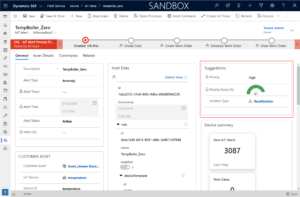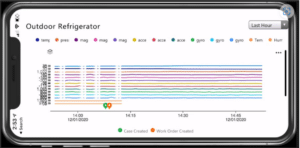Connected Field Service: Revolutionizing Field Service Management with IoT
Connected Field Service revolutionizes Field Service Management with IoT by using the latest and greatest IoT innovations.
Connected Field Service revolutionizes Field Service Management with IoT by using the latest and greatest IoT innovations.
Table of Content
“Connected field service,” as a concept, has been around for a while. Per Google’s first few pages of rankings, it’s been a “thing” at least since 2018.
Only recently has connected FS started gaining mainstream traction — among legacy field providers and the disruptive new entrants hoping to stake a claim on incumbent market share.
Connected field service is on the fast-track to buzzword status for a few key reasons.
Ever-rising customer expectations, exploding data sets, ongoing supply chain disruptions, a never-ending list of COVID ripple effects — just to name a few.
There’s also the fact that tech has become more accessible and affordable to the average provider — and everyone else. We’re seeing more field orgs benefit from democratized access to AI, ML, and the IoT.
At the same time, increased access has raised the bar for digital strategies, making it harder for field orgs to compete. It’s not enough to digitize operations and “go omnichannel.” Providers need to build intelligent, connected ecosystems that allow them to anticipate needs, adapt to change, and fuel long-term growth.
In this article, we look at how connected field service is changing FSM at its core — thanks, in large part, to the latest and greatest IoT innovations.
Connected Field Service refers to an organization’s ability to leverage the cloud, the IoT, and other systems and data sources to augment and improve existing field operations.
It’s important to understand connected field service in context with traditional field service management.
Typically, FSM refers to everything that goes into managing a company’s field ops, assets, and resources. Think — installing, repairing, and maintaining equipment, scheduling services, dispatching techs, communicating with customers, and so on.
More and more, these activities are facilitated by cloud-based platforms and specialized apps designed to help providers manage the thousands, maybe millions, of variables that might impact the service experience.
While moving to the cloud and digitizing field ops have a dramatic impact on business performance, they won’t fundamentally transform FSM in any meaningful way.
See, without the IoT, automation, and real-time data streaming, field orgs can’t break away from reactive service models.
Connected FS is similar to digital transformation in that the first step is building a strong foundation — moving to the cloud, consolidating systems, getting your data in order, etc. Then, from there, you can start building on those basic capabilities.
In this context, that means you’ll need to master traditional FSM solutions before transitioning to a connected field service model, which hinges on your ability to leverage advanced algorithms and massive, diverse data sets.
Per Salesforce, achieving “connected field service” from an agent perspective requires a 360-degree view of the customer and FSM tools that streamline work order management and daily operations.
Erica Ellis, a Principal Consultant at Velosio, advises field service leaders to start by “looking for opportunities to track things electronically. A lot of organizations, even ones with FSM solutions in place, still rely on old-school paper methods to run certain parts of the business.”
Field Service Consulting Manager Bill McGibony explains, “the biggest transformations will come from the shift away from the reactive break-fix approach and toward preventative maintenance strategies. However, it’s important to understand that you can only do this by capturing large amounts of data from existing assets, and slowly, building out predictive capabilities over time.”
Eventually, Bill says, you’ll get to the point where assets can monitor themselves using baked-in AI to analyze IoT insights. It’s just that it takes time, focus, and an org-wide commitment to see this whole thing through.
So, the Internet of Things (IoT) is just one part of the broader connected field service picture. But — it does most of the heavy lifting.
IoT sensors and devices allow field orgs to capture real-time data from customer assets, service fleets, and other connected sources. That information can then be used to make smarter, more profitable decisions and drive improvements across the entire org.
According to Velosio Principal Consultant & Solutions Architect Nelson Johnson, “a field service platform with embedded IoT capabilities is critical for detecting the environmental patterns that eventually cause system failures. That way, you can intervene before disaster strikes.”
For example, you might use IoT data to ensure the right person is assigned to the right job. Or — to configure your system so that it sends out alerts when customer assets are about to fail. That way, techs can jump into action and avert major crises.
You might also use those insights to automate tasks like scheduling and dispatching or create workflows that trigger specific actions. IoT data also plays a key role in driving consistent service experiences – for both the customer and the techs that serve them. (more context, etc.)
As mentioned, connected FS allows providers to leverage data from IoT-enabled devices to detect and diagnose problems before they occur – shifting away from the reactive model of old and toward something more proactive.
Bill says “the IoT enables orgs to detect and prevent issues before they occur, which benefits everyone from the provider itself to its employees, clients, and the end-users of each asset — say, homeowners or retail shoppers.”
Here’s an example from a recent Microsoft blog:
A client asset is embedded with a sensor that captures performance data. The sensor transmits that data back to your core system in real-time, and analyzes it against the information stored in your existing database — service histories, support requests, customer records, etc.
If an anomaly occurs, the system automatically flags the issue and raises an alert, which is then routed to the person in the best position to help. That might be a support agent, dispatcher, or a technician already out in the field.

So, let’s say an alert is routed to a technician.
In that case, the system might automatically generate a work order, pre-populated with data from the sensor, a complete service history, customer details, a list of parts, and a list of resources they can use to troubleshoot and fix the problem.
In D365 Field Service, techs can use the mobile app to check the latest device readings while servicing that particular asset.

While this is just one of many potential use cases, IoT data provides field orgs with more context for what’s happening on-site and in the field.
In turn, systems can be trained to detect issues, perform remote diagnostics, and use findings to match jobs to techs based on skills, location, and availability. What’s more, that information ensures techs arrive on-scene armed with the parts, tools, and context they need to dive right in and fix the problem — on the first visit.
Orgs can also monitor assets remotely, troubleshoot issues, and, in some cases, fix the problem without visiting the site at all. For example, AI chatbots can be trained to troubleshoot issues and guide customers through simple repairs, without human intervention.
Similarly, human techs can use IoT analytics and remote collaboration tools to walk customers through basic diagnostics or repairs – one step at a time. D365 users can also use IoT data to inspect assets without a work order.
Connected field service and the IoT have the potential to transform field service operations at every single level. This potent combination represents the true vision and promise of DX — the ideal future state software vendors use to educate, inform, and close six- (sometimes seven) figure deals.
The problem with this characterization isn’t that it’s wrong. Rather, it’s too broad, too general, and, usually, too light on things like tangible evidence, industry-specific use cases, or just a clear “why,” “how,” and “what to do next.”
Ultimately, connected field service is about building a connected ecosystem that supports everything from proactive service and AI analytics to automation, communication, and collaboration.
On the IoT side, connected sensors and devices capture the real-time data you need to actually support all these applications. More importantly, the IoT allows you to understand the full picture, detect & respond to emerging problems, anticipate customer needs, and prepare for all future scenarios.
And, yeah, our explanation is still pretty vague. But, that’s because the “benefits” of connected FS are relative to the unique needs of every business — and its customers.
In our line of work, much of the “DX conversation” begins and ends with the foundational elements — simply because, well, that’s where most clients are at. Here, we’re looking at what comes after you’ve migrated to the cloud, cleaned up your data, and trained your employees to work with the new tech — or maybe even leverage self-serve development and BI tools.
The point is, connected field service, done right, represents a path toward true, earth-shattering service transformation. See, once you “graduate” to more advanced FSM tech (IoT, AI, AR, automation, etc.), that’s when you can really start redefining how you work, engage with customers, and deliver real, measurable value.
Okay, we’ve established that connected field service and the IoT have really changed the game for field providers.
But – it’s important to understand that connected field service can’t happen unless you’ve already mastered the tools and tactics of traditional FSM. If your analog processes don’t work or you don’t have a solid data management strategy in place, you have no business messing around with the IoT or any sort of predictive algorithm.
The point is, connected field service is part of a bigger journey, and working with a partner like Velosio is an important step in the right direction. Contact us today to learn how our experts can support your journey – whether you’re just getting started or ready to venture into more advanced territory.